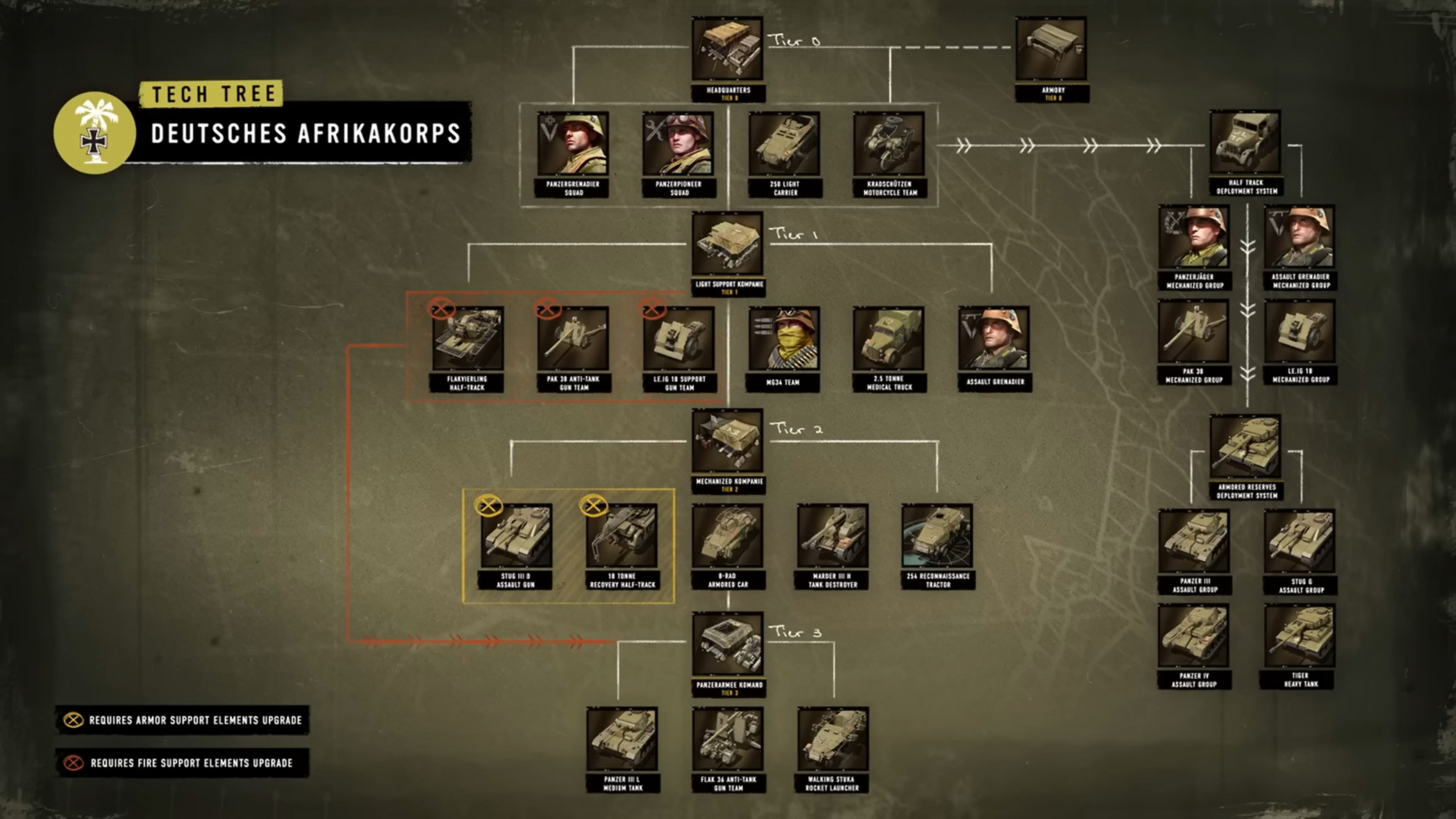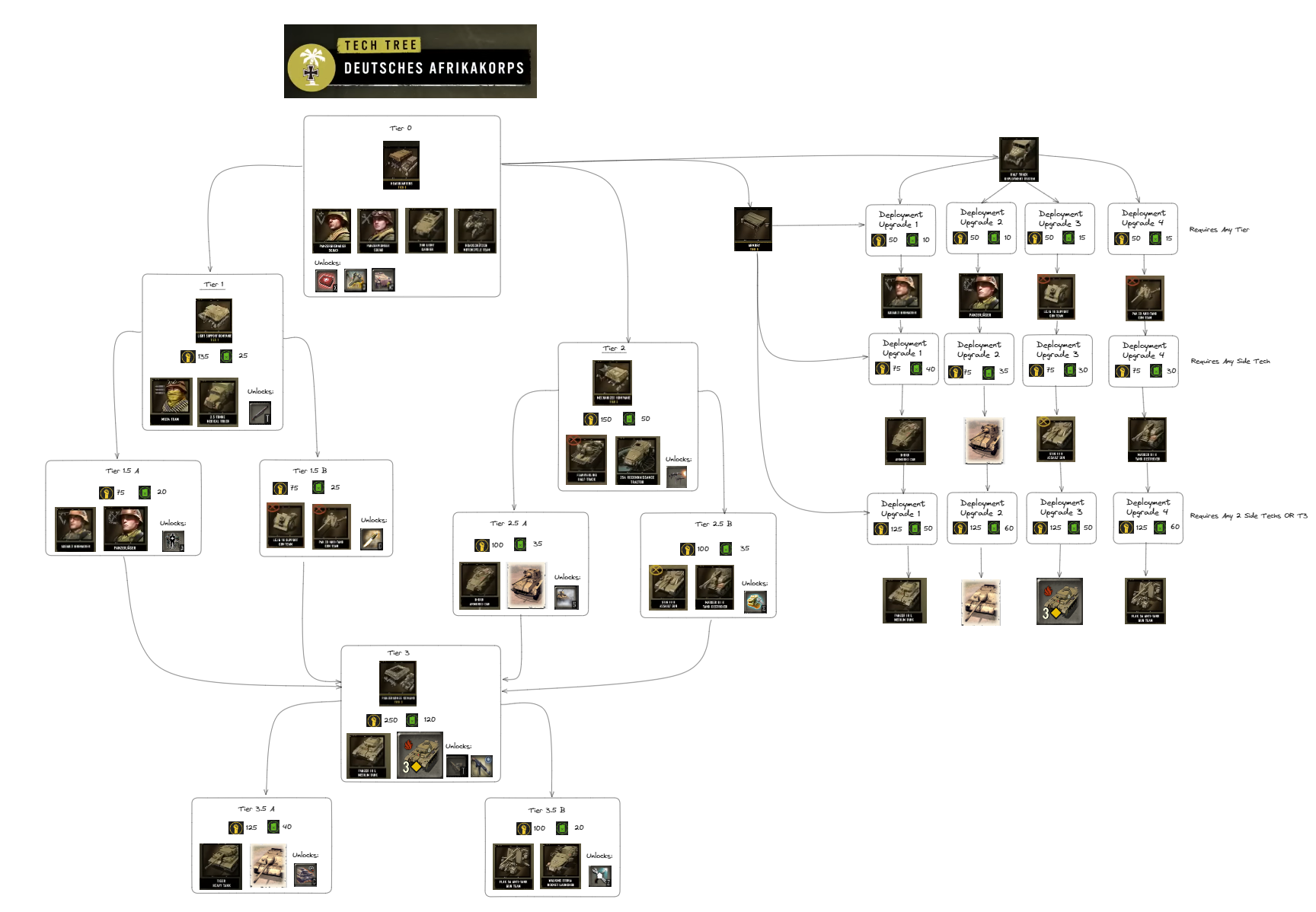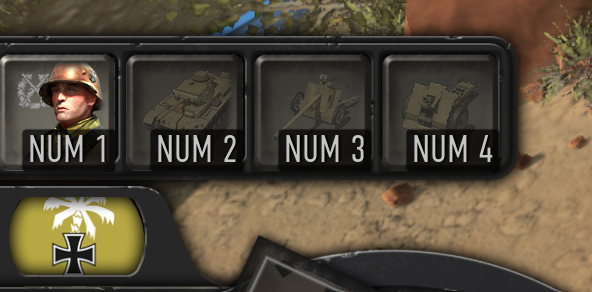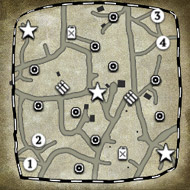To qualify my opinions, in Coh1 I was a top 200 ladder player and in Coh2 I’m currently 350ish, but I have not really played anywhere near as many games of Coh2 as I’ve been off doing real-life stuff ever since it came out basically. That’s my reference when I make the suggestions that I do.
Current design

Let’s take some observations of the current design and what personally I find stands to be improved:
Deployment System:
- Some people seem to be steadfastly against the deployment system, where the words ‘call in meta’ seem to be lurking beneath the resentment. Given the saga that was balancing Coh2 call in meta, you can absolutely understand why and I feel the deployment system has elements of these issues. My own main gripe with this mechanic is the ‘group’ and discount emphasis, which is balanced against having a long cooldown, which to me feels like not only a crude way of trying to balance this dynamic, it also skews balancing the individual units (as you’ll always perceive them after having been called in from a call in). You also always seem to end up with a plethora of 250 halftracks, regardless of whether you want them or not, and given that population cap is highly limiting in Coh3, not having the player agency to call in the unit you want without the burden of the 250, is a problem. Another problem is the way you upgrade the call in, it’s a blanket upgrade, either all the call ins change or none of them do, which again removes player agency (some players may always want that Pak call in). This really ought to be more granular. The upgrade also makes Panzer Jagers permanently unavailable, which isn’t great. However, having thought about it a bit, I actually feel the deployment system can be much improved and actually allow for significant strategic and build order depth if done correctly.
Tier 2.5
- I feel 2.5 (armoured support elements) is very much a pigeon holed tier which won’t see play. Both units are quite niche and the tech as a whole doesn’t play into the overall tech tree the same way tier 1.5 (fire support elements) does.
Linear Design
The developers themselves admit the design is linear, which is not as interesting as non linear tech tress.
Healing Is Tied to A 6-Pop Vehicle.
Its fairly annoying having 6 pop tied up in a vehicle that will for a majority of the time sit in your base.
These are essentially my main problems with the way the teching tree functions currently. This is what I propose gets changed:
New Design

The Description
I’m going to explain the changes first and then explain the rational after. The teching costs are rough and open to being changed.
First off, tier 0 stays basically the same except that it unlocks the grenade and 250 halftrack upgrades in the armoury immediately. Both of these upgrades should have a fuel cost added to them, it seems weird that they don’t have one already. I would also add another upgrade to the armoury for base headling which is also unlocked by tier 0. This means healing is no longer tied to the medical truck but the medical truck itself becomes more a unit you use for in field reinforcement and maintaining map presence. I feel simple base healing like this is a formula that should just not be messed with. Whenever a new take on healing is done it never ends up being better. Then after that, this is where things get different. Instead of being linear, you can now either tech T1 or T2.
Tier 1 has as a default the MG34 and the Medical truck. It also unlocks the MG34 upgrade for the Panzer Grenadiers. Tier 1 also now has two side tiers instead of one, which I call 1.5 A and 1.5 B. 1.5 A has access to Assault Grens and the Panzer Jagers and also unlocks the increased squad sizes upgrade in the armoury. 1.5 B has the ISG and the Pak, as well as the AP rounds upgrade. Incidentally, the hollow round and AP round ability for both the ISG and the Pak should be locked behind this ability instead of vet.
Tier 2 has the Flak-halftrack and the observation halftrack as standard, but it also unlocks an MP40 upgrade for Panzer Grens (although you could use MP44s if you really want to full PE on this). Tier 2 also has two side tiers instead of one, which I call 2.5 A and 2.5 B. 2.5 A has access to the the 232 Armoured Car and also the Puma. I replaced the recover halftrack with the puma because the DAK have so many repair options already (too many to be fair) that it was totally superfluous. The Recover HT feels a much better fit for a doctrine or even Wehr. 2.5 A also unlocks the smoke screen upgrade in the armoury. 2.5 B instead unlocks the Stug III D and also the Marder, as well as the emergency repairs upgrade in the armoury.
Tier 3 becomes available once any of the side tiers have been purchased. It contains the Panzer 3 and the Panzer 3 Flamethrower variant as well as unlocking a Panzer Schrek upgrade for Panzer Jagers and Stg44s for Panzer Grenadiers. The Panzer 3 Flamethrower variant is replaced by the Recovery HT in the doctrine. This tier no longer has a call ins upgrade but instead two side tiers; 3.5 A and 3.5 B. The first, 3.5 A, unlocks the tiger and the Jagd Panzer IV and also the Blitz upgrade (or whatever that is called) in the armoury. 3.5 B unlocks the walking stuka and the flak 36 as well as the global repairs buff in the armoury.
That’s the basic tier structure sorted, now for the deployment system. This radically changes. First off, I would remove all the 250 halftracks that come bundled in the deployment and also remove the infantry add ons for the deployments once they get upgraded. What you see is what you get. Also, all call-ins should cost exactly the same, if not a slight premium over, what they cost in the standard tech. The deployment balancing relative to normal tech should basically hinge on a trade off of instant build time but a long recharge rather than the discount system they have in place now. Next, all the deployments has individual upgrades in the Armoury, which change what the call in would be, so that you have more control over what units you have available to call in.
Note that each deployment requires a different upgrade just to be used for the first time, this upgrade requiring any tier. For the first deployment level, all the units are the same as they are now; Assault Grens, Panzer Jagers, ISG and Pak. However, once you have any side tier, you can upgrade any deployment (presuming you already have the first upgrade of that respective deployment). For example, Assault grenadiers can be replaced with a 232, Panzer Jagers can be replaced with the Puma, the ISG with the Stug III D and the Pak with the Marder. Finally, once you get any 2 side techs or T3, you can upgrade the deployment again. This time, the 232 becomes a Panzer III, the Puma becomes a Jagd Panzer IV, the Stug D becomes a Flampanzer and finally the Marder becomes the Flak 36. Its highly important to stress that each deployment’s upgrades are totally separate from the other deployment upgrades and also that the fuel costs are for demonstrative purposes.
The Logic
So this is how the logic goes. I’ll start with the tiers, a T1 vs T2 split in the early game is just more interesting than linear tech in my opinion. Tier 1 is now cheaper so it should allow players to get MG 34s faster, this is similar to when OKW had their tech and medic upgrades split to make their teching less of an up front cost. Likewise, since the most powerful units of T2 are locked behind side tiers, T2 is much less of a commitment, allowing you to get a Recon HT earlier. In many ways, this works a lot like how the original PE worked in that you could build the tier to get access to some of the units but others were locked behind an upgrade. This allowed for a lot more flexibility in teching, as no one tech was so much of a commitment. Having T1 unlock the MG34, T2 unlock MP40s and T3 unlock Stg44s for panzer grens is an interesting nuance that the original PE had and I can’t see how the DAK would be worse off with it.
T1.5 A is the most infantry orientated tech path, however it lacks heavy weapons of any kind. Its aggressive and mobile. T1.5 B is much more static and support weapon orientated. It’s the most natural ‘camp’ tech path. T2.5 A is again aggressive but this time mechanised, its highly mobile and is somewhat reminiscent of Luchs and Puma combo in OKW. Finally 2.5 B is mobile, but not quite as mobile, given the vehicles are turretless, their more focused on long range firepower. This setup also removes the original tier 2.5 that would have seen little play, as the Recovery HT is gone and Tier 2.5 B is much more well rounded relative to the other options available.
Once you have one of the tiers, your options become interesting. You can either go for the upgrades in the armoury, side tech into one of the other tiers, either from T1 to T2 from T2 to T1, or indeed for T1.5A to T1.5B or T2.5A to T2.5B, or any combination really, but you can also go straight to T3. You might want to do this to rush out a Flamepanzer in the same way you rush an Ostwind in Coh2, or go for that fast medium. Then in T3 you also have to decide whether to stall for Tiger, get more substantial tank destroyers in the form of the Jagd Panzer or get those more powerful support elements.
There are a plethora of teching paths basically.
How do the deployments factor into this? Basically by making the other teching choices yet more flexible by giving you the option to call in units that you didn’t tech for in your tech path. For example, let’s say you tech T1 and then T1.5, leaving out possible doctrinal vehicles, how would you get a light vehicle to round out your composition? You could tech T2 or alternatively, you could upgrade Deployment 1 twice and call in a 232. Another example, let’s say you go T2 -> T2.5A, you get a 232 but you your opponent has gone Chafee and you don’t have the fuel for a Puma or side teching Marder, you could either tech T1 or upgrade deployment 4 and panic call in a Pak.
The advantage is you can augment whatever your tech choices are and react quickly to your opponent’s choices. Naturally you have to point out the disadvantages. This form of getting units is riskier because if you lose that unit you called in, you’re going to have to wait a whole 6 minutes to call it in again or do the teching afterall. This method, while seemingly a cheaper alternative to teching to certain units, its also is just much less efficient for getting access to all those units. In the example I’ve created, getting all the T1.5 units via deployments is 50 mp 5 fuel more expensive than if you had just teched those units directly, but a straight tech to a Pak is 10 fuel cheaper, assuming you already have T1 in both scenarios. It’s a trade off of flexibility and reproducibility for cheaper straight teching costs. The deployments also don’t give you access to the upgrades.
Changes to Some units
250 HT:
This really needs a Pak36 upgrade, for a unit that is clearly designed to add flexibility to the army comp of DAK, I can’t see why a light mobile AT option isn’t there. In my design, this would compliment T1.5A and T1.5B nicely.
Panzer Jagers:
These really should have a Panzer Schrek upgrade at T3 to help them scale. And ditch the MG34 upgrade.
Flak HT.
I would be way happier if this worked a lot more like the OKW Flak Halftrack, that was a way more interesting unit.
Conclusion
This design has a lot of advantages over the current design.
- The teching options are significantly more diverse, with a non-linear tech tree and fairly esoteric tech options removed.
- The deployment system is tidied up and tied into the tier system more elegantly. It has a clear cut purpose of adding rounding out your composition and tech choices by allowing you to ‘tech’ certain units without all of the upfront costs while also having considerable draw backs relative to teching itself. It’s a trade-off.
- Healing is easier.
This is just what I would do anyway, let me know your thoughts.






















 cblanco ★
cblanco ★  보드카 중대
보드카 중대  VonManteuffel
VonManteuffel  Heartless Jäger
Heartless Jäger 